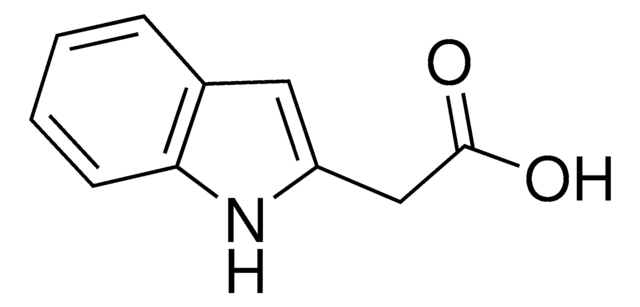I5148
Indole-3-acetic acid sodium salt
BioReagent, suitable for plant cell culture, ≥98%
Synonym(s):
3-IAA, IAA, indolylacetic acid, Heteroauxin
About This Item
Recommended Products
grade
for molecular biology
product line
BioReagent
Assay
≥98%
form
powder
technique(s)
cell culture | plant: suitable
solubility
H2O: soluble
suitability
suitable for (Plant cell culture)
application(s)
agriculture
storage temp.
2-8°C
SMILES string
[Na+].[O-]C(=O)Cc1c[nH]c2ccccc12
InChI
1S/C10H9NO2.Na/c12-10(13)5-7-6-11-9-4-2-1-3-8(7)9;/h1-4,6,11H,5H2,(H,12,13);/q;+1/p-1
InChI key
YGSPWCVTJRFZEL-UHFFFAOYSA-M
Related Categories
General description
Application
- to alter the root developmental processes in Arabidopsis thaliana seedlings
- as a standard for the determination of IAA by high-performance liquid chromatography using Chlorella sorokiniana and Azospirillum brasilense sample culture media
- as one of the plant hormone to treat interspecific hybrids (Elaeis oleifera Cortés x Elaeis guineensis Jacq.) and study its effect on bunch formation in parthenocarpic fruits and oil production in oil palm
- as a supplement in culture media to induce mitotic slippage in human cell lines
- as a supplement in a shoot induction medium (SIM) for shooting and shoot elongation from explant
Biochem/physiol Actions
Storage Class Code
11 - Combustible Solids
WGK
WGK 3
Flash Point(F)
Not applicable
Flash Point(C)
Not applicable
Personal Protective Equipment
Certificates of Analysis (COA)
Search for Certificates of Analysis (COA) by entering the products Lot/Batch Number. Lot and Batch Numbers can be found on a product’s label following the words ‘Lot’ or ‘Batch’.
Already Own This Product?
Find documentation for the products that you have recently purchased in the Document Library.
Customers Also Viewed
Our team of scientists has experience in all areas of research including Life Science, Material Science, Chemical Synthesis, Chromatography, Analytical and many others.
Contact Technical Service









